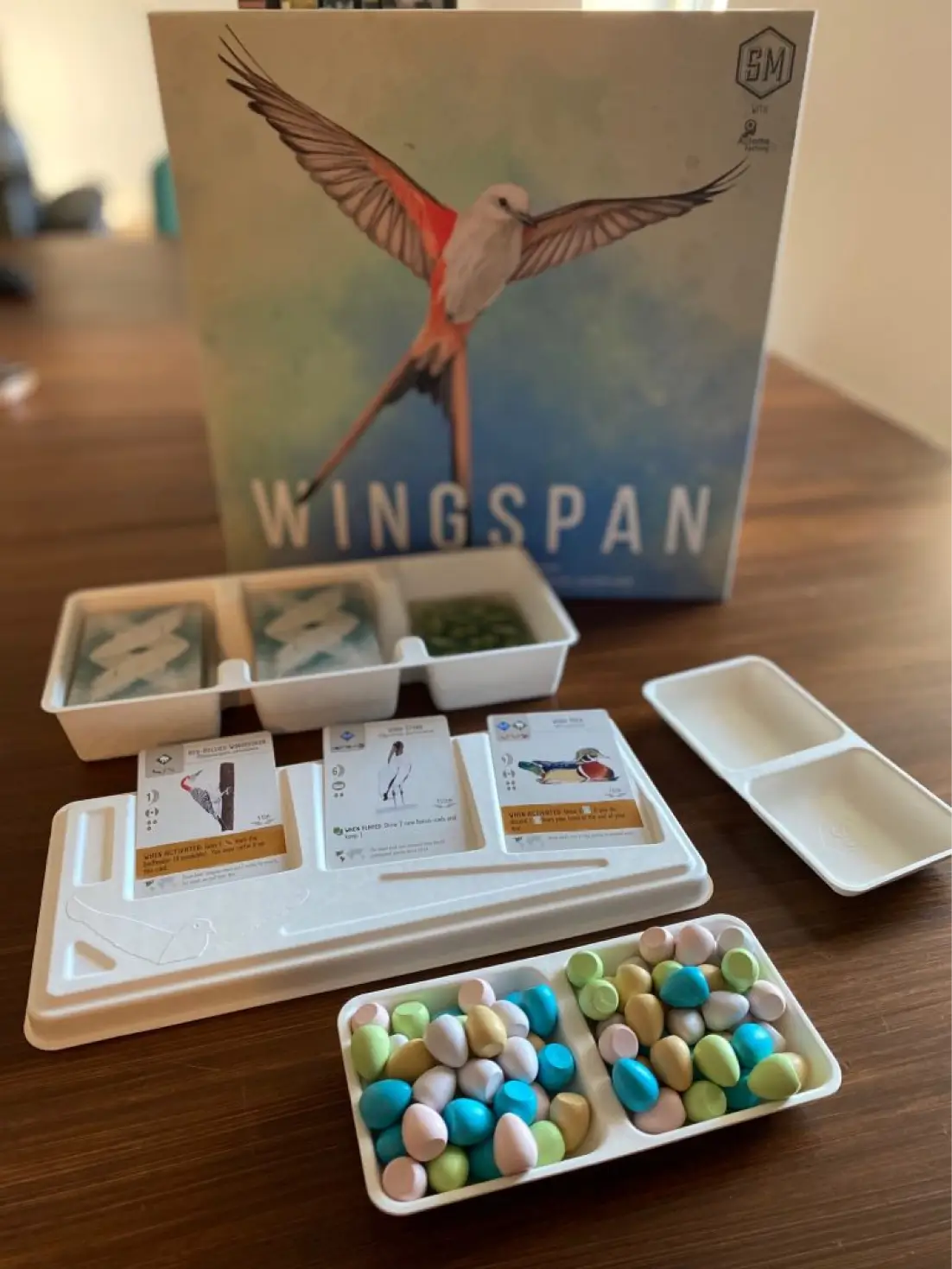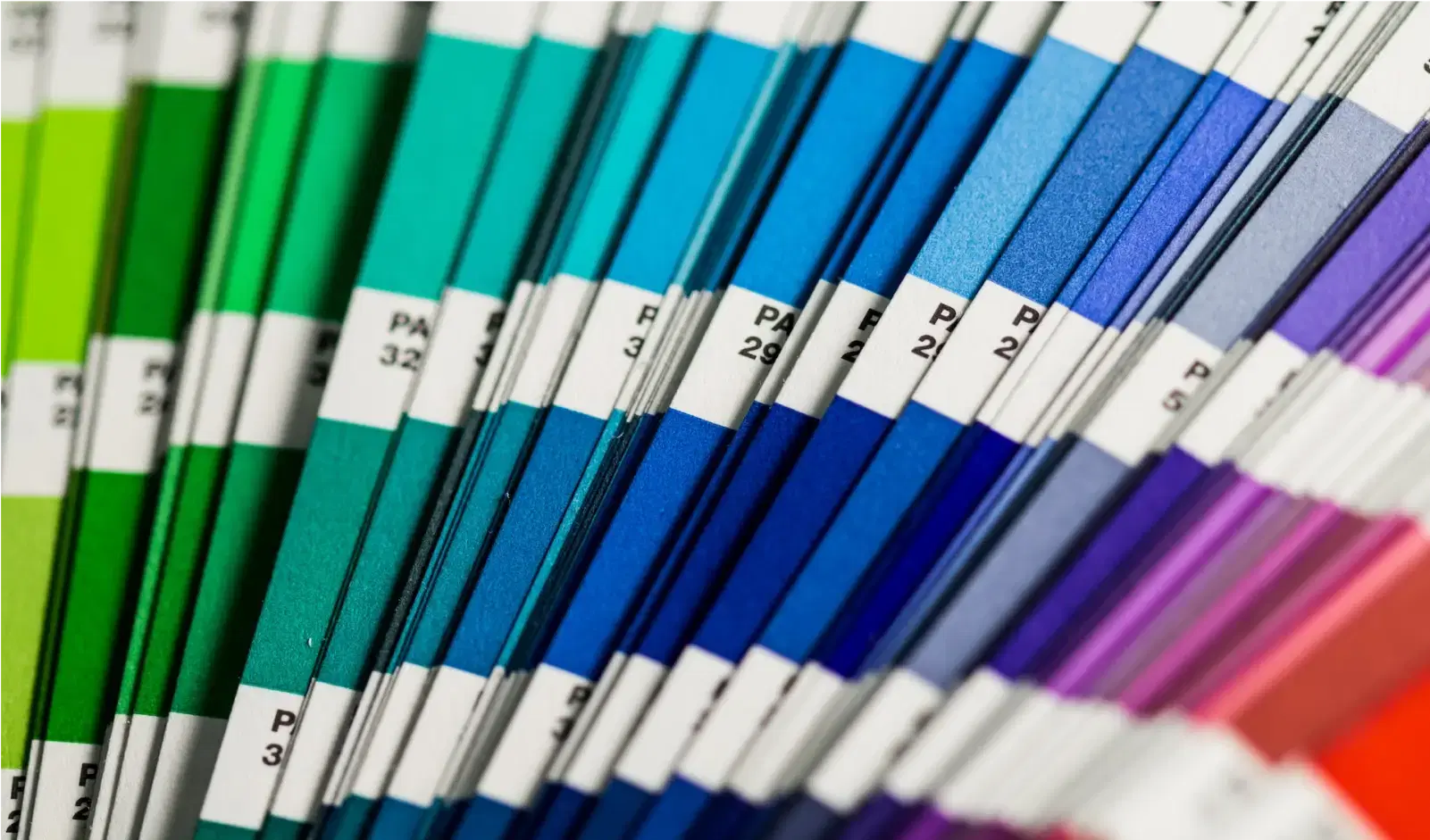Tips & tricks
Go green with your game
Make your gaming habits more sustainable and environmentally friendly with easy and practical tips!
This article isn't here to make you feel bad about your hobby. Simply existing comes with an environmental cost, and as far as hobbies go, tabletop games are relatively low-impact: it's a small industry, and games tend to be kept and re-used for years on end rather than being treated as consumables. We can always do better, though.
Tania Walker, 23 Aug 2023
Colourful Pantone swatches
When you're setting out to manufacture a greener game, there are two factors to consider: what happens when your game is created, and what happens when it is destroyed.
We'll cover these factors below, but only in brief - we're not about problems here: we're about solutions. You'll find nine concrete ideas on how to make a greener game below, all using materials, components and services offered by Launch Tabletop. It's never been easier to go green.
The environmental cost of boardgames
The cost of creation
Every game is made of a variety of materials - wood, metal, plastic, cardboard, paper, etcetera - and each of those materials comes with a carbon footprint. This is a measure of how much carbon dioxide is pumped into the atmosphere by obtaining, preparing, and moving that material. Wood has a low carbon footprint; plastic a much higher one. The quantity of your order, your choice of component materials and inclusions, the dimensions of your game box, your approach to shipping, and even your graphic design can all affect your game's carbon footprint.
The cost of destruction
As much as we'd love to imagine our games will be treasured forever, someday all objects reach the natural end of their lifespan. The more recyclable materials used in your game, the less will end up in landfill. But not all materials biodegrade equally: a wooden piece will naturally decompose within a few years, whereas the same size plastic piece might take half a century to break down. The components and packaging you choose can improve your game's biodegradability.
There's so much to think about when juggling those costs. What if a material is recyclable but comes with a high carbon footprint - or vice versa? No matter which materials and approaches you opt for, the fact is that all manufacturing comes with an environmental cost - but by following these simple guidelines, you can vastly reduce that cost.
Solutions for greener games
1. Cardboard is king
If you're searching for a foolproof way to keep your game green, cardboard components are your best bet. Cardboard has a small carbon footprint, it's biodegradable, and it's lightweight to ship. Launch Tabletop's custom cardboard components are manufactured from recycled materials, too, so you can rest easy knowing nothing was dug up or cut down to bring your game to life.
When looking at the Launch Tabletop Component Library, particularly at thicker cardboard items like game boards and game boxes, you'll see the phrase 'grey board' come up. This is a material somewhere between a heavy cardboard and a light particle board, formed by compressing layers of recycled newspaper and packaging pulp together. It doesn't get much more environmentally friendly than that.
Consider the other advantages of cardboard: it's cheaper than wood or plastic, takes up less space in the box (potentially allowing you to choose a smaller box size - more on that later), and is easier to print on. Launch Tabletop's custom cardboard game components cost you less, and cost the environment less too.
2. Wood for the win
Looking for game components or tokens with more heft than cardboard? Wood is the word.
Farmed from sustainable timber plantations, Launch Tabletop's wooden components offer a drastically lower carbon footprint than plastic or metal game pieces, while still providing heft, table presence, and a pleasantly natural tactile feel. They're available in a range of shapes and sizes bursting with vibrant colour, so choosing them over plastic won't mean sacrificing visual flair. We can even print custom designs onto them.
Best of all, you can rest easy knowing that the trees that grew your game components added oxygen to the atmosphere while they lived - and when your games are laid to rest someday, they will return harmlessly to the earth.

Wood is the word (Image credit: Lee Vaughan)
3. The mighty ziplock baggie
After all this praise of wood and cardboard it might seem strange to recommend plastic, but hear us out.
When games are manufactured with card decks inside, those decks are typically shipped in single-use plastic wrap to stop the cards from scattering throughout the box. This type of packaging is extremely single-use, and perhaps the single most wasteful element in modern games: disposed of in five minutes, it will take decades to break down in landfill.
Instead, consider ordering ziplock baggies as part of your game. When you order baggies, your cards and components are shipped sealed inside the baggies to keep components from shifting during transit. The key difference between baggies and plastic wrap is that baggies are designed to be reused - you can repack your game into them at the end of each session, keeping your components organised and in mint condition. These baggies become a vital and lasting part of the game, and serious collectors will love you for including them.
We'd call that 'killing two birds with one stone' but we're willing to bet it's going to save some birds.
TIP: If your budget allows, take this idea to the next level by including fabric drawstring bags with your game instead.
4. Replace consumables with reusables
Running with the above concept, here's another way to replace a disposable game part with something built to last: consider swapping out scoresheet pads for dry-erase boards. Launch Tabletop offers customisable dry-erase boards in various sizes, printed with your designs. The initial outlay may be slightly more than ordering a pad of scoresheets, but you'll never run out, never need to order any replacements, and never generate pages of crumpled trash with each gameplay.
Like paper components, our dry-erase boards are biodegradable, and created from recycled materials. And let's face it: dry-erase boards look classier than plain paper, too.
5. Think small
It's not all about the components. Keeping your game box as small as possible can reduce your carbon footprint from moose to mouse.
Consider: have you chosen the smallest possible game box to house your components? Can you tweak your design or reimagine your components to reduce the overall size of your game? A smaller game comes with multiple advantages, environmental and otherwise:
- Cheaper (and less carbon-intensive) to ship
- Often preferred by collectors struggling with already-crowded shelves
- Easier to take to parties = more likely to be introduced to a wider audience
- Less likely to require an insert to stop components shifting
- Less plastic wrap required for protection during shipping
- Less materials required for manufacture overall = lower environmental cost
When it comes to the environment, small is mighty!
6. Consider print-on-demand
Building on the previous point, it's worth considering how many games you need to print in one hit. Not every creator can afford to mass manufacture, ship, and store board games at quantities of 5000 or more. For all those reasons, and for the sake of the environment, print-on-demand can be a better solution.
With custom print-on-demand board game manufacturing , games are only printed and shipped out to meet orders as they come in. This means no excess stock. Zero waste. And if you end up with a hit on your hands, Launch Tabletop also offers mass production: we started this company to help small creators like you scale up over time.
But until that day comes, choose print-on-demand: it's less pressure on you and the environment.
7. Hire a great designer and editor
On the theme of 'smaller is better', talented designers and editors can help you cut down text and arrange it in such a way that you can opt for a more compact rulebook with fewer pages. Slimming down your rulebooks may not sound like something that can save the world, but if you remove just four pages from a rulebook across a print run of 5,000, that's 20,000 fewer sheets of paper that need printing, manufacturing and recycling. It all adds up.
8. Rethink plastic inserts
Ouch. This one hurts, because plastic inserts are pretty cool, but that's a lot of plastic just to achieve a slightly neater box - which 99% of the time, nobody will see. If the main concern here is keeping your components together, consider the ziplock or drawstring baggies covered in Tip #3.
Producing plastic-free custom trays
An industrial designer who focusses on packaging can come up with very clever ways of folding thin corrugated cardboard (CCB) to form strong paper trays. CCB can be coated with plain white or printed paper to look more attractive than unbleached CCB.
- The retail edition of Wonderland's War used a pair of folded paper trays to get a very heavy game safely from the factory to the table.
- Bagasse (the leftover unbleached sugar cane pulp from producing sugar) can be molded into trays. Bagasse is recyclable and a more sustainable solution than using wood pulp from trees. You can see bagasse trays in action in later printings of Wingspan from Stonemaier Games.

Bagasse trays are now standard in Wingspan (Credit: Stonemaier Games)
Launch Tabletop doesn't currently offer plastic inserts as an option, which makes avoiding them a very easy and environmentally-friendly choice!
9. Talk it over with us
When you start creating your game with Launch Tabletop, you'll be assigned a project manager to guide you through the process and help you get the best results. And we mean the best results by your metric: if creating an environmentally-friendly board game is of prime importance to you, your project manager can advise you of the best approach specific to your game.
Head filled with ideas? Got a question for us, or a clever suggestion that ought to be on this list? Reach out - we'd love to hear from you!\
Image credit:
Photo by Christina Rumpf on Unsplash
Keywords
Related articles in 'Tips & tricks'
Build your game on a budget
Tania Walker, 28 Aug 2023
Boost your game's table presence
Tania Walker, 28 Aug 2023

